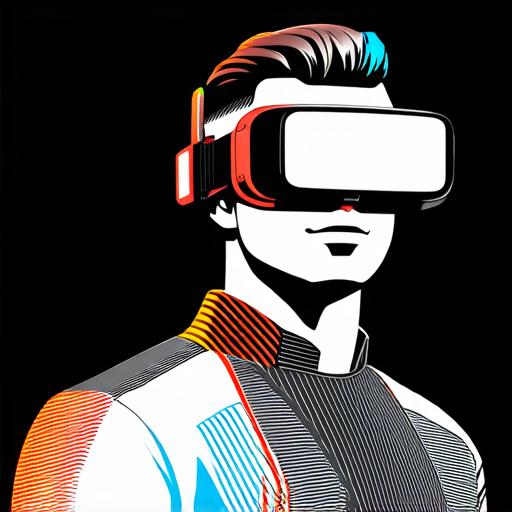What Are Virtual Reality Glasses?
Virtual reality glasses are wearable devices that simulate a three-dimensional environment, allowing users to immerse themselves in a virtual world. These glasses use advanced technology such as stereoscopic displays and motion tracking to create a realistic experience, making it possible for developers to design and test VR applications more efficiently and effectively.
The Advantages of Virtual Reality Glasses for VR Developers
-
Enhanced Immersion: Virtual reality glasses provide an enhanced immersion experience that allows developers to fully immerse themselves in a virtual environment, making it easier to design and test applications. By wearing the glasses, developers can visualize how their designs will look and feel, allowing them to make adjustments in real-time, leading to faster development cycles and higher quality products.
-
Increased Productivity: Virtual reality glasses are designed to be lightweight and easy to use, making it possible for developers to work remotely or while on the go. This increased flexibility can lead to increased productivity as developers can work wherever and whenever they need to, without being constrained by physical space or time.
-
Cost-Effective: Virtual reality glasses are a cost-effective solution for VR development, especially when compared to traditional methods such as physical prototyping. By using virtual reality glasses, developers can create and test designs more quickly and efficiently, reducing costs associated with production and testing.
-
Reduced Risk: Virtual reality glasses allow developers to test their designs in a safe environment, reducing the risk of injury or damage to physical objects. This is particularly important for applications that involve heavy machinery or other potentially dangerous elements.
-
Improved Collaboration: Virtual reality glasses make it possible for developers to collaborate more effectively with colleagues and clients from anywhere in the world. By wearing the glasses, developers can share their vision and experience in real-time, allowing for faster decision-making and better communication.
Case Studies: The Real-World Benefits of Virtual Reality Glasses
-
Designing Medical Devices: In the medical industry, virtual reality glasses are being used to design and test medical devices such as prosthetics and surgical instruments. By wearing the glasses, designers can visualize how their designs will look and feel on a patient’s body, allowing for faster and more accurate prototyping.
-
Developing Gaming Applications: Virtual reality glasses are also being used in the gaming industry to design and test VR games. By wearing the glasses, developers can create an immersive gaming experience that is more realistic and engaging, leading to higher player engagement and better sales.
-
Building Architectural Models: In the architecture industry, virtual reality glasses are being used to build and test architectural models. By wearing the glasses, architects can visualize how their designs will look and feel in real life, allowing for faster and more accurate prototyping.
-
Designing Fashion Accessories: Virtual reality glasses are also being used in the fashion industry to design and test fashion accessories such as clothing and shoes. By wearing the glasses, designers can visualize how their designs will look and feel on a model’s body, allowing for faster and more accurate prototyping.
The Science Behind Virtual Reality Glasses: How They Work
Virtual reality glasses use advanced technology to create a realistic three-dimensional environment that simulates the real world. The glasses consist of two screens, one for each eye, that display slightly different perspectives from each eye. This creates an illusion of depth and movement that allows users to feel as though they are in a physical space.
The glasses also use motion tracking technology to track the user’s movements and adjust the environment accordingly. This allows developers to create interactive applications that respond to the user’s actions, making it possible to design and test applications more efficiently and effectively.
FAQs: Frequently Asked Questions About Virtual Reality Glasses
1. What are virtual reality glasses?
Virtual reality glasses are wearable devices that simulate a three-dimensional environment, allowing users to immerse themselves in a virtual world.
2. What are the advantages of using virtual reality glasses for VR developers?
The advantages include enhanced immersion, increased productivity, cost-effectiveness, reduced risk, and improved collaboration.
3. What industries are using virtual reality glasses?
Virtual reality glasses are being used in a variety of industries including medical devices, gaming, architecture, and fashion.
4. How do virtual reality glasses work?
Virtual reality glasses use advanced technology such as stereoscopic displays and motion tracking to create a realistic three-dimensional environment.
5. Can I wear virtual reality glasses while on the go?

Yes, virtual reality glasses are designed to be lightweight and easy to use, making it possible to work remotely or while on the go.
Summary: The Power of Virtual Reality Glasses for VR Developers
Virtual reality glasses are a powerful tool for VR developers that can enhance immersion, increase productivity, reduce costs, improve collaboration, and reduce risk. By using virtual reality glasses, developers can create more accurate and engaging applications in less time, leading to better products and higher customer satisfaction. As the technology continues to evolve, we can expect to see even more exciting uses for virtual reality glasses in the future of VR development.
